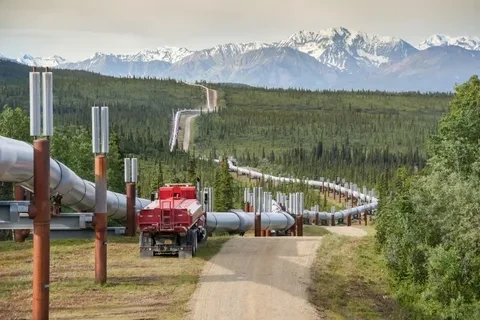Virtual Pipeline to Reach USD 2.02 Billion by 2032, Growing at a 5.4% CAGR
The Virtual Pipeline Market is poised for significant expansion, with its size projected to grow from USD 1.26 billion in 2023 to USD 2.02 billion by 2032. This anticipated growth, driven by a compound annual growth rate (CAGR) of 5.4% over the forecast period of 2024-2032, highlights the increasing importance of Virtual Pipeline systems in providing flexible and efficient transportation of natural gas to regions without access to conventional pipeline networks.
A Virtual Pipeline refers to a system that transports compressed natural gas (CNG), liquefied natural gas (LNG), or other gaseous fuels through non-pipeline methods, such as trucks, ships, or rail. These systems offer a cost-effective solution for delivering gas to remote areas, industrial facilities, and transportation hubs, where traditional pipeline infrastructure may not be feasible.
Key Drivers
Several factors are driving the growth of the Virtual Pipeline :
- Rising Demand for Clean Energy: As global efforts to reduce carbon emissions intensify, natural gas has emerged as a cleaner alternative to coal and oil for power generation, industrial processes, and transportation. Virtual Pipelines facilitate the efficient distribution of natural gas to regions where pipelines are unavailable, contributing to the global shift towards cleaner energy sources.
- Growing Industrialization and Urbanization: The rapid industrialization and urbanization in emerging economies are creating a strong demand for reliable energy sources. Virtual Pipelines are being increasingly used to supply natural gas to industries, power plants, and residential areas in regions with underdeveloped gas infrastructure.
- Flexibility and Cost-Effectiveness: Virtual Pipeline systems offer greater flexibility compared to traditional pipelines, as they can be deployed quickly and scaled according to demand. This flexibility is particularly beneficial for temporary or seasonal gas supply needs, reducing the cost of infrastructure development.
- Government Support and Energy Security: Governments across the globe are implementing policies to promote the use of natural gas as part of their energy security strategies. Virtual Pipelines are playing a vital role in ensuring a steady supply of natural gas to regions without access to pipeline networks, thereby enhancing energy security.
Segmentation
The Virtual Pipeline is segmented based on fuel type, application, and region, with each segment contributing to the overall growth of the .
By Fuel Type:
- Compressed Natural Gas (CNG): CNG is expected to dominate the , driven by its wide use in transportation and industrial applications. CNG offers several advantages, including lower emissions, cost-effectiveness, and ease of storage and transportation.
- Liquefied Natural Gas (LNG): The demand for LNG is growing rapidly, especially in regions with limited gas infrastructure. LNG is favored for long-distance transportation due to its high energy density and ease of conversion back to gas form. The use of LNG in marine and heavy-duty transport is also contributing to growth.
- Other Gaseous Fuels: This category includes alternative gaseous fuels, such as biogas and hydrogen. As interest in renewable energy sources grows, the for these fuels is expected to expand, especially in industrial and transportation sectors.
By Application:
- Transportation: The transportation sector is expected to see substantial growth in the adoption of Virtual Pipelines. CNG and LNG are increasingly being used to fuel vehicles, particularly in regions with strict emissions regulations. Virtual Pipelines are playing a crucial role in supplying gas to fueling stations for public transportation fleets, trucks, and marine vessels.
- Industrial and Commercial: Virtual Pipelines are widely used to supply natural gas to industrial and commercial facilities, including manufacturing plants, power generation units, and large commercial establishments. The demand for Virtual Pipelines in this segment is driven by the need for a consistent and cost-effective energy supply in areas without pipeline infrastructure.
Regional Outlook
The global Virtual Pipeline is experiencing diverse growth patterns across different regions, driven by varying energy demands and infrastructure development.
- North America: North America is expected to dominate the Virtual Pipeline during the forecast period, owing to its robust natural gas infrastructure and the increasing adoption of LNG and CNG in transportation and industrial applications. The U.S. is leading the way with investments in Virtual Pipeline solutions to meet the growing demand for natural gas in remote and underserved regions.
- Europe: Europe is anticipated to witness significant growth in the Virtual Pipeline , driven by the region’s transition towards cleaner energy sources and stringent regulations aimed at reducing carbon emissions. The demand for CNG and LNG in the transportation and industrial sectors is contributing to the expansion of Virtual Pipeline systems across Europe.
- Asia-Pacific: The Asia-Pacific region is projected to experience the fastest growth in the Virtual Pipeline , fueled by rapid industrialization and urbanization in countries such as China, India, and Southeast Asian nations. The growing energy needs of these countries, coupled with the lack of pipeline infrastructure in many areas, are creating opportunities for the deployment of Virtual Pipeline systems.
- Rest of the World: The Virtual Pipeline in Latin America, the Middle East, and Africa is also expected to grow steadily, driven by increasing investments in natural gas infrastructure and the need for reliable energy supplies in remote and developing regions.
Trends and Opportunities
Several key trends are shaping the future of the Virtual Pipeline :
- Increased Adoption of Renewable Natural Gas (RNG): As sustainability becomes a priority for businesses and governments, the demand for renewable natural gas (RNG) is expected to rise. RNG, derived from organic waste, offers a carbon-neutral alternative to conventional natural gas. Virtual Pipelines can play a pivotal role in transporting RNG from production sites to end-users.
- Technological Advancements: Innovations in gas storage, transportation, and compression technologies are improving the efficiency and cost-effectiveness of Virtual Pipeline systems. Advances in cryogenic storage for LNG and high-pressure containers for CNG are enabling longer-distance transportation and larger capacities.
- Expansion of LNG Marine Transport: The use of LNG as a marine fuel is gaining traction, driven by environmental regulations aimed at reducing sulfur emissions in the shipping industry. Virtual Pipelines are emerging as a critical component in the supply chain for LNG bunkering stations at ports, enabling the refueling of LNG-powered vessels.
Conclusion
The Virtual Pipeline is poised for strong growth over the next decade, driven by the increasing demand for natural gas as a cleaner and more flexible energy source. With its ability to deliver natural gas to remote and underserved regions, Virtual Pipelines are playing a crucial role in the global energy transition. As governments and industries continue to invest in cleaner energy solutions, the Virtual Pipeline is set to expand, offering significant opportunities for stakeholders across the value chain.
Read More Details @ https://www.snsinsider.com/reports/virtual-pipeline-market-3138
Contact Us:
Akash Anand – Head of Business Development & Strategy
Phone: +1-415-230-0044 (US) | +91-7798602273 (IND)
SNS Insider Offering/ Consulting Services:
Go To Market Assessment Service




